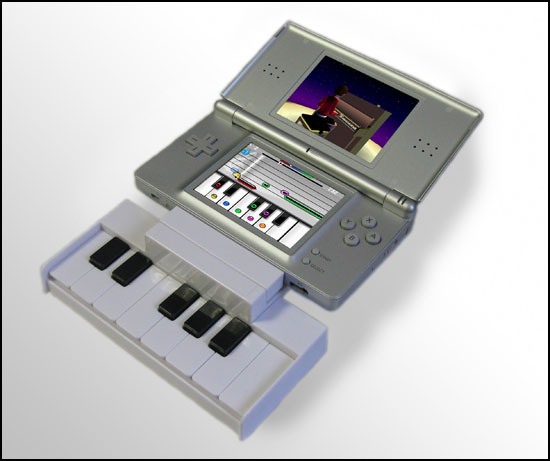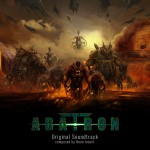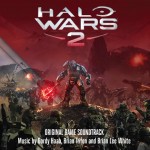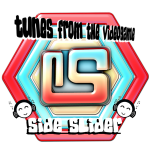I have to say that this piano peripheral is adorable. It seems like music peripherals are a dime a dozen these days, but this octave-spanning plastic piano plugged into the bottom of my DS has to be one of my favorites of all time. While that doesn’t mean it’s used to its fullest in Easy Piano, it does mean that I had a lot of fun with it.
So, what is Easy Piano about, anyway? Well, it’s not advertised only as a music teaching tool, but also as a sort of rhythm game that allows you to play along with over 30 songs. Now, don’t go in expecting to be a music master after playing Easy Piano, but you may find yourself picking up some music skills from the many lessons, songs to play along with, and even the composition mode that allows you to test your music-writing abilities.
All of this and more in our review of Easy Piano after the jump.
I had a bit of a crash course with this game at GDC, and I have to say that it was all a bit overwhelming at first. However, if you take the time to go through the 10 music lessons presented in Easy Piano, you should do just fine in the performance and composition modes. The lessons are informative and oftentimes fun, usually requiring you to use the touch screen aspect of the DS as opposed to the piano peripheral to complete mini-games that are meant to teach you the basics of reading music. I found drawing the bass and treble clefs in a race against the clock to be a lot of fun along with one of the games that requires you to drag notes off the musical staff into baskets at the bottom of the screen. Eventually you make your way to playing the piano peripheral in the final lessons, which is simply a blast. I also dug the fact that the instructor tells you to “destroy the notes!” by playing the various keys, which sends stars flying from the clef to blow up the incoming notes.
I was frustrated more than once, however, when the stylus wasn’t as responsive as I would have liked. Additionally, a few of the lessons are a little less helpful, including the first lesson that asks you to fill in the lines on the musical staff so that notes do not fall through. The only benefit I found from this lesson was learning how to draw straight lines on the DS (a challenge in itself). There’s also one much later about tempo that is impossible to figure out the time they’re looking for when they ask you to tap and hold for full, half, and quarter notes. Finally, the lesson on chords is way too difficult with the amount of information they give you, as they tell you “chords are combinations of notes that sound good together,” then ask you to complete chords without any knowledge of which combinations of note to use. At least the game automatically unlocks the next lesson for you, even if you fail, so you won’t get stuck on these less-than-worthwhile activities.
It’s then on to piano mode, which is basically the game’s rhythm game mode. There’s a brief tutorial that explains what is essentially a Guitar Hero-esque rhythm game with the piano. Instead of real notes on a musical staff, the notes instead appear as colored bars that correspond to a visual colored keyboard on the bottom of the screen. Not very musical, but at least they’re lined up correctly on the staff. You start with one song in each category (classical, standards, anthems, and pop), and must get 80% on each song to unlock the next. I completely skipped anthems, which included national anthems, and standards, which included “Wedding March” and “Happy Birthday.” The pop section includes “ABC,” “Come Away With Me,” “Our House,” “Material Girl,” and “Chariots of Fire” among others. I stuck with the classical section for the most part, which includes the largest portion of songs, from “Canon” and “Fur Elise” to “Can Can” and “Gymnopedie No. 1” to name a few. I actually had a lot of fun with this, and found it useful in learning how to sight read. While there are difficulties (Beginner and Virtuoso) to choose from, I started with and stuck with the latter, as “Beginner” is much too simple and boring, and is probably better suited for children. To spice things up, players can also unlock different outfits, pianos, and venues that are displayed on the top screen, although you’ll likely be too focused on the bottom screen to even notice the changes.
The final mode is the composer mode. You can save up to three songs, and enter your notes via the piano peripheral or touch screen. You can generate chords with up to three notes, and enter in either the bar-based visual style I mentioned above, or using actual music notation, which is pretty awesome. I plugged in a few bars of some songs I wrote a long time ago for kicks and was impressed with how it turned out. The piano sample that’s used throughout this mode and the rest of the game is pretty good, but you can also play the tracks back in MIDI sax, guitar, and others, all of which sound terrible and should be avoided. Stick with the piano.
Visually, Easy Piano is very solid. There’s a lot of color, and I like the sleek user interface. I guess you can’t really go wrong when you’re mainly dealing with a musical staff, but they did a good job making sure the note colors stood out, especially when there are 8 notes to work with. The female character doesn’t look horribly mutated like they tend to in the Guitar Hero series, and even the main screen that you select the different modes from looks good.
Overall, I’m impressed with how well Easy Piano turned out. It could have easily been a complete disaster: a slopped-together gimmick to get parents to buy it for their kids. While not all of the mini-games are worthwhile, at least they’re relatively easy to bypass, and the ones that do work do so quite well. I feel like my music abilities have improved, including my sight reading (although that bass clef is a pain), and I’ve even learned a few new things. The rhythm game mode will probably be good for a one-time play through, but the composition mode is a great way to test everything that the game has taught you. I really love piano peripheral and wish other developers would make use of it, but some may feel it makes the unit too bulky, and then there’s the issue with it only working with old DS units that have a GBA port. Still, I think it’s reasonably priced at $39.99 given that it comes with the peripheral in the box, and is actually entertaining and educational. It’s available at select retailers, including Walmart and Amazon if you’re interested.
What do you think of Easy Piano? Think they should have tossed some game music into the mix in the piano mode?
Tags: Easy Piano, Game Review, Music Education, Music Reviews, Reviews, Rhythm, Valcon Games








































